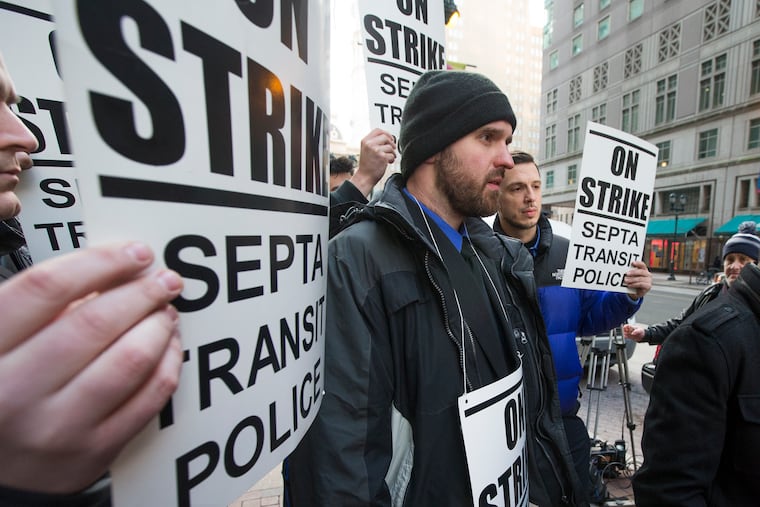The difference between the SEPTA police strike and the recent teachers’ strikes — and why it matters
In recent years, unions have changed gears and sought to align their struggles with that of the public, and it's worked. But the SEPTA police strike veers from that new school of thinking.

As nearly 200 SEPTA police officers went on strike Wednesday over work rules, including whether they could review body camera footage before providing statements for investigations, there was one notable difference between their messaging and the high-profile teachers’ strikes that have swept the country in the last year:
The absence of talk about the public good.
In Los Angeles this January, for example, 30,000 teachers went on strike over wages, but also over issues they said affected everyone in the county: class size, the role of charter schools, the need to hire support staff like counselors and librarians.
Experts call it “social justice unionism” or “bargaining for the common good," and the approach has been on display in Philadelphia with unions supporting “Fair Workweek” scheduling legislation as an antipoverty measure, the building trades backing a rally for immigrant rights last summer, and labor groups joining coalitions to fight for a slate of progressive issues in the 2019 primary.
This strategy — aligning labor interests with those of the public — gained traction in the last decade, as union membership steadily dropped and labor faced unprecedented attacks. As Sarah Lawrence College labor historian Priscilla Murolo put it in the 2018 reissue of her book, From the Folks Who Brought You the Weekend: A Short, Illustrated History of Labor in the United States, “To survive, let alone grow, unions had to expand their agenda far beyond wages, hours, and working conditions and become organizations that closely linked day-to-day efforts to empower workers on the job with longer-range struggles for justice in society at large.”
>> READ MORE: Why labor has embraced immigrant rights — and 9 more examples of Philly intersectionality
Social justice unionism, experts say, is what the labor movement needs right now because it gets the public on the side of workers — especially as anti-union rhetoric seeks to discredit striking workers by describing them as greedy and selfish.
Bargaining for the common good has largely worked: The Los Angeles teachers settled their contract after a weeklong strike, winning caps on class sizes and a commitment to hire one librarian for every middle and high school by 2020. Teachers elsewhere in the country, such as Kentucky, have said that public support was key to winning their fights.
Omari Bervine, president of the Fraternal Order of Transit Police Lodge 109, which represents all of SEPTA’s officers, said his primary duty is to protect the rights of his members, and often that aligns with the public’s interest. After all, he said, like teachers, police officers serve the public.
But he said he wasn’t interested in framing the story of the strike just to appeal to the public for its support. “We’re interested in telling the truth." If people disagree with the reason the union is on strike, that’s their prerogative, he said.
Civil rights groups, though, believe the union’s stance is at odds with the good of the public: If officers can review footage before providing a statement, it could shape how officers recount an incident. Police accountability has become a pressing public issue after a series of high-profile cases where unarmed black people were killed by police.
Still, Bervine disagrees that his union’s position goes against the public interest. “An officer viewing the footage before making a statement does not have a negative impact on the public good, because the public’s need has already been served by [an incident] being recorded,” he said.
Officers should be able to review footage before providing a statement, he said, because if their statement differs from what’s on the video, officers could unintentionally perjure themselves. “This is not a controversial position,” he said, noting that it’s the policy for the Philadelphia Police Department. At least 74 other police departments across the country have similar policies, according to a 2017 report.
Meanwhile, another union in Philadelphia is gearing up for a strike — the one representing faculty and staff at Community College of Philadelphia — and leaders have sought to frame the battle as one for public education in a city plagued by poverty, though the strategy’s effectiveness has yet to be tested.